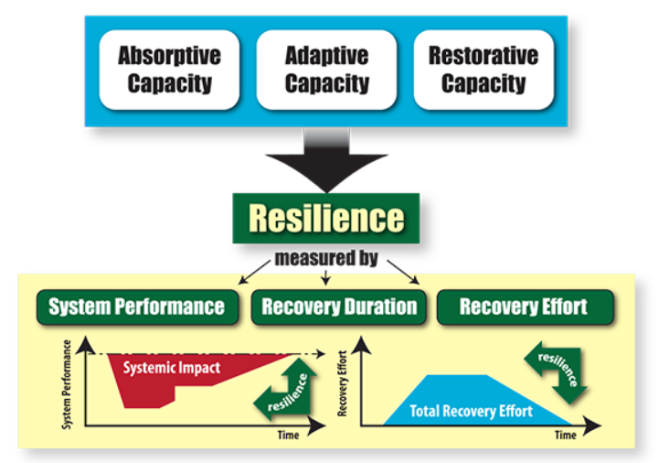Resilience is the capacity of a system to proactively and positively manage disturbance and reorganize while undergoing change so as to still retain essentially the same function, structure, identity, and feedbacks.
A system made up of elements which provide essential services which are vital for a system to remain viable and sustainable and satisfy its purpose (function, structure, identity, and feedbacks). Critical system resilience is determined by the system ability deliver essential service at maximum performance in the event of disruptive incidents, by how it absorbs and recovers from those disruptive events.
System resilience capacity consists of:
- Absorptive capacity
It is the capacity to take intentional protective action and to cope with known shocks and stress. Simply stated this is the capacity to ‘bounce back’ after a shock. It involves anticipating, planning, coping and recovering from stress and known shocks. Absorptive capacity is about ensuring stability and maintenance of the possible maximum performance.
- Adaptive capacity
This is the capacity to make intentional incremental adjustment in anticipation of or in response to change in ways that create more flexibility in the future. Adaptive capacity is about flexibility and the ability to make incremental changes on ongoing basis through process of continuous learning, adjustments and innovation: fundamental to dynamic changing systems.
- Restorative capacity
This is the ability of system to be repaired easily, efficiently and can be considered as the last line of defense because it requires the greatest amount of effort and in not normally applied unless absorptive and adaptive capacities are not able to maintain an acceptable level of performance. In most instances restorative capacity is needed when system is broken and unable to perform. Restorative capacity involves repairs that are implemented with the goal of returning to a system something near its orginal structure; if possible depending on stability ladnscape, trajectory and tipping points.
A key differentior is that restorative capacity directly impacts Total Recovery Effort (resource usage) whereas aborptive and adaptive capacity primarly effect the cumulative System Impact on System Perfromance and may reduce recovery duration and effort thereby reducing System Impact.
Repairs to the system enabled by restorative capacity inpact System Performance (drain) and may reduce recovery duration by reducing System Impact.
While adaptive capacity reflects ability of a system to be changed endogenously (within regime or basin of attraction), restorative capacity and involves changes that can radically alter structure of the system (new regime) to restore System Performance or even enhace System Performance (transformation) .

Resilience can be measured as follows:
- Theoretical Maximum System Performance (TMSP); variables:
- Theoretical Maximum System Performance defined by maximum system potentiality of the current regime
- Percentage maximum TMSP
- Value TMPSP variables (currency, units)
- Actual System Performance (ASP) ; variables (currency, units)
- System impact variables linked to TMSP
- Recovery ;
- Time /cost to restore operation
- Time / cost to restore configuration/ re-configure
- Time/cost to restore functionality/performance
- Degree to which pre-disruption state is restored
- Potential disruption circumvented
- Successful adaptation within time and cost constraints
